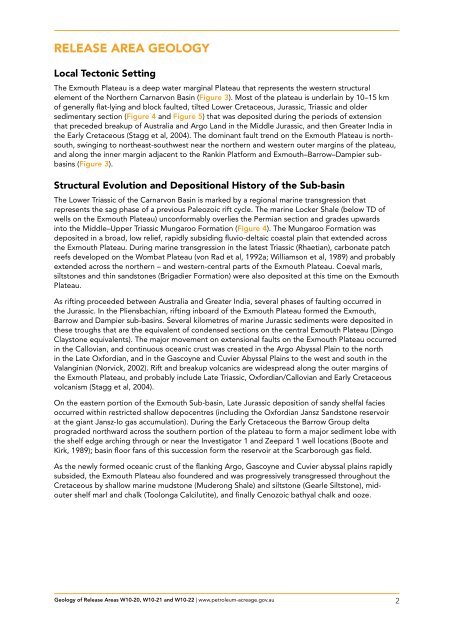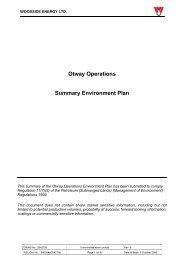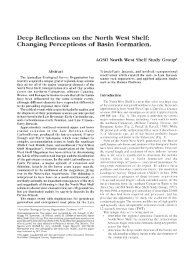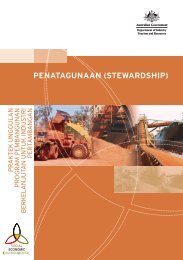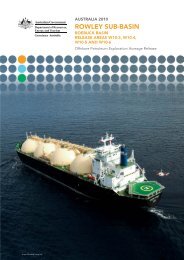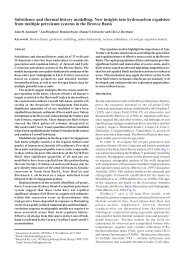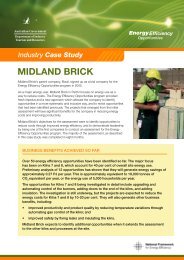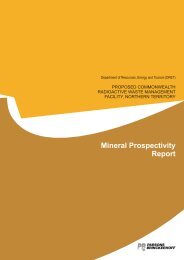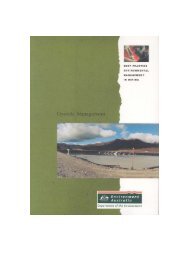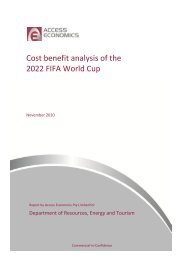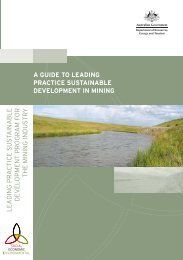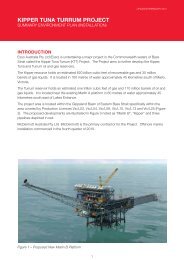W10-20 - Department of Resources, Energy and Tourism
W10-20 - Department of Resources, Energy and Tourism
W10-20 - Department of Resources, Energy and Tourism
Create successful ePaper yourself
Turn your PDF publications into a flip-book with our unique Google optimized e-Paper software.
eleAse AreA geology<br />
local tectonic setting<br />
the Exmouth Plateau is a deep water marginal Plateau that represents the western structural<br />
element <strong>of</strong> the northern carnarvon basin (Figure 3). most <strong>of</strong> the plateau is underlain by 10–15 km<br />
<strong>of</strong> generally flat-lying <strong>and</strong> block faulted, tilted lower cretaceous, Jurassic, triassic <strong>and</strong> older<br />
sedimentary section (Figure 4 <strong>and</strong> Figure 5) that was deposited during the periods <strong>of</strong> extension<br />
that preceded breakup <strong>of</strong> Australia <strong>and</strong> Argo l<strong>and</strong> in the middle Jurassic, <strong>and</strong> then Greater india in<br />
the Early cretaceous (stagg et al, <strong>20</strong>04). the dominant fault trend on the Exmouth Plateau is northsouth,<br />
swinging to northeast-southwest near the northern <strong>and</strong> western outer margins <strong>of</strong> the plateau,<br />
<strong>and</strong> along the inner margin adjacent to the Rankin Platform <strong>and</strong> Exmouth–barrow–dampier subbasins<br />
(Figure 3).<br />
structural evolution <strong>and</strong> depositional history <strong>of</strong> the sub-basin<br />
the lower triassic <strong>of</strong> the carnarvon basin is marked by a regional marine transgression that<br />
represents the sag phase <strong>of</strong> a previous Paleozoic rift cycle. the marine locker shale (below td <strong>of</strong><br />
wells on the Exmouth Plateau) unconformably overlies the Permian section <strong>and</strong> grades upwards<br />
into the middle–upper triassic mungaroo formation (Figure 4). the mungaroo formation was<br />
deposited in a broad, low relief, rapidly subsiding fluvio-deltaic coastal plain that extended across<br />
the Exmouth Plateau. during marine transgression in the latest triassic (Rhaetian), carbonate patch<br />
reefs developed on the Wombat Plateau (von Rad et al, 1992a; Williamson et al, 1989) <strong>and</strong> probably<br />
extended across the northern – <strong>and</strong> western-central parts <strong>of</strong> the Exmouth Plateau. coeval marls,<br />
siltstones <strong>and</strong> thin s<strong>and</strong>stones (brigadier formation) were also deposited at this time on the Exmouth<br />
Plateau.<br />
As rifting proceeded between Australia <strong>and</strong> Greater india, several phases <strong>of</strong> faulting occurred in<br />
the Jurassic. in the Pliensbachian, rifting inboard <strong>of</strong> the Exmouth Plateau formed the Exmouth,<br />
barrow <strong>and</strong> dampier sub-basins. several kilometres <strong>of</strong> marine Jurassic sediments were deposited in<br />
these troughs that are the equivalent <strong>of</strong> condensed sections on the central Exmouth Plateau (dingo<br />
claystone equivalents). the major movement on extensional faults on the Exmouth Plateau occurred<br />
in the callovian, <strong>and</strong> continuous oceanic crust was created in the Argo Abyssal Plain to the north<br />
in the late Oxfordian, <strong>and</strong> in the Gascoyne <strong>and</strong> cuvier Abyssal Plains to the west <strong>and</strong> south in the<br />
Valanginian (norvick, <strong>20</strong>02). Rift <strong>and</strong> breakup volcanics are widespread along the outer margins <strong>of</strong><br />
the Exmouth Plateau, <strong>and</strong> probably include late triassic, Oxfordian/callovian <strong>and</strong> Early cretaceous<br />
volcanism (stagg et al, <strong>20</strong>04).<br />
On the eastern portion <strong>of</strong> the Exmouth sub-basin, late Jurassic deposition <strong>of</strong> s<strong>and</strong>y shelfal facies<br />
occurred within restricted shallow depocentres (including the Oxfordian Jansz s<strong>and</strong>stone reservoir<br />
at the giant Jansz-io gas accumulation). during the Early cretaceous the barrow Group delta<br />
prograded northward across the southern portion <strong>of</strong> the plateau to form a major sediment lobe with<br />
the shelf edge arching through or near the investigator 1 <strong>and</strong> Zeepard 1 well locations (boote <strong>and</strong><br />
Kirk, 1989); basin floor fans <strong>of</strong> this succession form the reservoir at the scarborough gas field.<br />
As the newly formed oceanic crust <strong>of</strong> the flanking Argo, Gascoyne <strong>and</strong> cuvier abyssal plains rapidly<br />
subsided, the Exmouth Plateau also foundered <strong>and</strong> was progressively transgressed throughout the<br />
cretaceous by shallow marine mudstone (muderong shale) <strong>and</strong> siltstone (Gearle siltstone), midouter<br />
shelf marl <strong>and</strong> chalk (toolonga calcilutite), <strong>and</strong> finally cenozoic bathyal chalk <strong>and</strong> ooze.<br />
Geology <strong>of</strong> Release Areas <strong>W10</strong>-<strong>20</strong>, <strong>W10</strong>-21 <strong>and</strong> <strong>W10</strong>-22 | www.petroleum-acreage.gov.au 2


